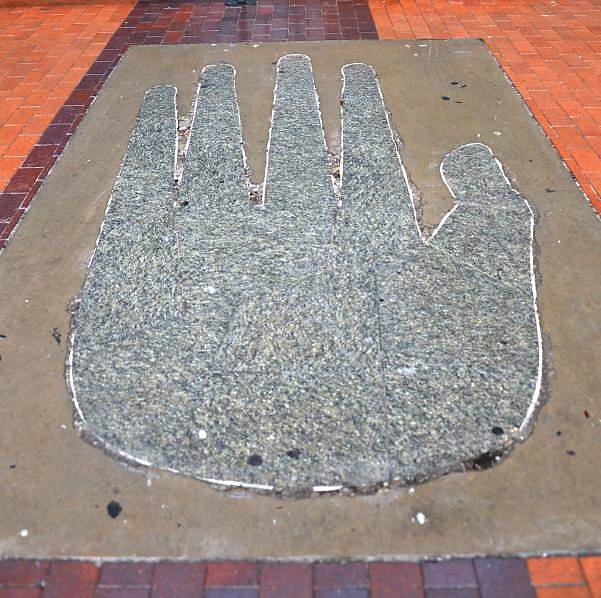Dr. Phil Wanyerka, archaeologist at Cleveland State University, came across a familiar image in a surprising place. In the following guest blog, he shares his delight in the unexpected discovery! ___________________ While Christmas shopping in downtown Cleveland this past December, I literally stepped across one of the most iconic effigy images in Ohio archaeology lying on the ground in front of the old Cleveland Arcade. Located near the Euclid Avenue entrance to the Arcade is a larger-than-life, six foot tall, exact rendering of the famed Hopewell Mica Hand effigy. As an archaeologist, I quickly said to my friend “I wonder who placed this iconic image here and why?” In hindsight, I seem to recall having seen this image once before, but didnt think much about it at the time. However, this time with camera in hand, I quickly snapped several photos of this most unexpected find. The Cleveland Arcade was the first building in Cleveland to be placed on the National Register of Historic Places. It was originally designed by John M. Eisenmann and George H. Smith to reflect a Romanesque Revival style, which was a common Victorian style, for public buildings during this era. The Cleveland Arcade opened in 1890 and is considered Americas first indoor shopping mall. Today, the Cleveland Arcade is home to a Hyatt-Regency Hotel. The placement of this iconic image outside the entrance to the Cleveland Arcade is puzzling and I am now trying to track down its history. Im quite familiar with Mayan-Revival style architecture and sculpture, but until now I had never seen anything in a “Hopewellian-Revival” style before. The Arcade underwent a $60 million renovation in 2001 and from what I can gather so far, it seems likely that this was image was placed there perhaps as part of these renovations. The native peoples of Ohio, especially the Hopewell, used mica to craft important ceremonial and ritual objects. Mica is a reflective mineral that occurs in thin translucent sheets and is not found naturally in Ohio. Rather the closest source for mica comes from the Appalachian Mountains of the Carolinas.
While Christmas shopping in downtown Cleveland this past December, I literally stepped across one of the most iconic effigy images in Ohio archaeology lying on the ground in front of the old Cleveland Arcade. Located near the Euclid Avenue entrance to the Arcade is a larger-than-life, six foot tall, exact rendering of the famed Hopewell Mica Hand effigy. As an archaeologist, I quickly said to my friend “I wonder who placed this iconic image here and why?” In hindsight, I seem to recall having seen this image once before, but didnt think much about it at the time. However, this time with camera in hand, I quickly snapped several photos of this most unexpected find. The Cleveland Arcade was the first building in Cleveland to be placed on the National Register of Historic Places. It was originally designed by John M. Eisenmann and George H. Smith to reflect a Romanesque Revival style, which was a common Victorian style, for public buildings during this era. The Cleveland Arcade opened in 1890 and is considered Americas first indoor shopping mall. Today, the Cleveland Arcade is home to a Hyatt-Regency Hotel. The placement of this iconic image outside the entrance to the Cleveland Arcade is puzzling and I am now trying to track down its history. Im quite familiar with Mayan-Revival style architecture and sculpture, but until now I had never seen anything in a “Hopewellian-Revival” style before. The Arcade underwent a $60 million renovation in 2001 and from what I can gather so far, it seems likely that this was image was placed there perhaps as part of these renovations. The native peoples of Ohio, especially the Hopewell, used mica to craft important ceremonial and ritual objects. Mica is a reflective mineral that occurs in thin translucent sheets and is not found naturally in Ohio. Rather the closest source for mica comes from the Appalachian Mountains of the Carolinas.
 Phil Wanyerka
Phil Wanyerka